
UCLA Samueli Announces 2021 Commencement Awards
By UCLA Samueli Newsroom
Each year, the UCLA Samueli School of Engineering and its departments outstanding graduating students with significant accomplishments and important contributions. Below is an overview of this year’s school-wide award recipients, along with questions-and-answers with the awardees on their UCLA experiences.
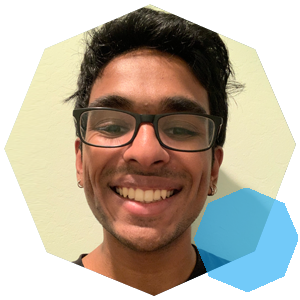
2021 Outstanding Bachelor of Science Award
Arjun Subramonian
Subramonian graduated in March 2021 with a bachelor’s degree in computer science. They earned summa cum laude honors and received an honorable mention as an outstanding undergraduate researcher from the Computing Research Association. They were the co-founder of QWER Hacks, Outreach Director for ACM AI at UCLA, Logistics Director for ACM Teach LA at UCLA, Diversity and Inclusion Advisor for ACM at UCLA, and a core organizer for Queer in AI. During their time at UCLA, they also participated in the AAAI Undergraduate Consortium, IBM Quantum Challenge, Out for Undergrad Tech Conference, Google Queer Tech Voices Conference, and won third place for best hack in Major League Hacking’s Rose Hack in 2019. Subramonian also participated in research with the Ozcan Research Group, Scalable Analytics Institute (ScAi) and UCLA-NLP, and they interned with the Allen Institute for Artificial Intelligence, Microsoft and Heal. Subramonian is pursuing a doctoral degree in computer science with Professor Yizhou Sun at UCLA Samueli, supported by a Eugene V. Cota-Robles Fellowship.
Q&A
What has been your most rewarding experience at UCLA, and why?
I collaborated with amazing queer and trans (QT) students at UCLA to organize QWER Hacks, Major League Hacking’s first LGBTQIA+ event and the first collegiate LGBTQIA+ hackathon in the U.S. We empowered and increased the visibility of the QT community in tech, and brought together QT individuals and allies through the creation of products that benefit marginalized groups in STEM. I was blown away by the creative and impactful applications engineered by the attendees. These included an app that leverages augmented reality to allow trans and non-binary people to experiment with gender expression, an online game through which parents can practice supporting their QT child via role-playing, a website that connects QT individuals to queer-friendly health services and so many other innovations in health care, education, entertainment, and public policy!
My QWER Hacks co-organizers became my family; we worked together many days a week for months — contacting sponsors, securing a venue, marketing the event, processing applications, and brainstorming ways to enhance hacker experience and ensure a safe and inclusive space for everyone. It was inspiring to work with such driven individuals, with a genuine passion for increasing representation in tech. Their perseverance, enthusiasm and support were contagious. I received amazing advice from them on how to stay organized, manage my time and boost morale as a leader. QWER Hacks was truly transformative, as it launched me into the world of advocating for the diverse, brilliant and talented queer people in tech! Most importantly, I am grateful that my QWER Hacks co-organizers created a space for me to embrace my identity and be openly queer in tech.
During your time at UCLA, you’ve played a crucial role in building equitable spaces. What have you learned through this process, and what advice do you have for other UCLA students who aspire to participate in similar work?
While at UCLA, I fervently championed diversity and inclusion by creating and growing inclusive spaces and communities. For example, I collaborated with other queer and trans students at UCLA to organize QWER Hacks, the first collegiate LGBTQIA+ hackathon in the U.S. Furthermore, as Outreach Director of ACM AI at UCLA, I worked to make an AI education accessible to everyone, organizing and teaching machine learning and ethics classes at Title I Los Angeles schools and helping develop interactive educational technology on AI concepts. I also created the “You Belong in AI!” podcast, which empowers marginalized students to pursue AI through inspiring interviews with researchers. Additionally, I led diversity and inclusion initiatives within ACM at UCLA, hosting allyship spaces and employing actionable goal setting and reflection to take concrete steps in making the organization more welcoming of everyone, through increased accessibility, inclusive language and mental health support.
I learned so much while building these spaces and communities! First and foremost, I learned to always listen to and amplify often-erased voices. The first step in achieving this was to acknowledge my own positionality and regularly remind myself of the privileges from which I benefit. By doing so, I became better at reaching out to and understanding the lived experiences of marginalized individuals. This directly translated into creating more inclusive spaces.
Simultaneously, it is important to lead with self-confidence. While organizing diversity and inclusion initiatives, I would find myself constantly adjusting in response to critical feedback; however, I’ve learned that while most critical feedback is valuable, some of it can be misguided, or the result of miscommunication. I now have more confidence in my ideas that are founded in community research, and I frame critical feedback as a response to me not conveying my ideas clearly.
Furthermore, I learned that if you don’t see a space for yourself and other individuals who share your identity, be loud and demand change. And if you can, create that space. For instance, QWER Hacks was born out of frustration with a lack of spaces for LGBTQIA+ individuals in computer science. When creating spaces from scratch, like we did for QWER Hacks, it’s important to be persistent; the experience will be tough and consume a lot of emotional and physical labor.
Finally, I urge every UCLA student leader to make diversity and inclusion a top priority in their organizations, integrate it into every meeting and event they run, and importantly not let this responsibility fall on the marginalized individuals in the room. Additionally, it’s critical to identify and acknowledge inequities in your organizations, especially through an intersectional lens, and work to mitigate them. The best way to do this is to regularly brainstorm concrete diversity and inclusion goals as an organization and reflect on your progress towards them./p>
Could you describe your journey in research at UCLA?
An exciting random walk on a graph of creativity and learning — this is how I view machine learning (ML) research. Every paper and discussion with collaborators excites me. I’m on a never-ending quest to sate my curiosity while contributing to the exciting bleeding edge of ML. I hop from literature survey to discussion to implementation to experimentation nodes, traveling along edges of discovery and growth as a researcher.
I began my collegiate journey in research in the UCLA Ozcan Research Group, designing a neural network for a deep learning-based optical system that inexpensively detects microbial resistance to antibiotics. The system significantly shortens the timeline of prescribing antibiotics to patients in resource-limited settings. My mentors and I published a manuscript on our work in ACS Photonics. Although I enjoyed applying deep learning to mitigate global antimicrobial resistance, I yearned to delve further into ML.
Hence, I joined UCLA’s Scalable Analytics Institute (ScAi), where I became enamored of graph representation learning (GRL). Graphs fascinate me because they are conceptually simple yet information-dense data structures, and they subsume nearly every form of raw data with which we interact. They can represent images, sentences, maps and molecules! However, graph semantics are more elusive than image and natural language semantics — cropping an image can preserve its meaning, but perturbing the topology of a graph may not. This sparks my curiosity to understand how we can make GRL more interpretable and apply it to graph mining.
At ScAi, I worked on the Heterogeneous Graph Transformer (HGT), to efficiently embed web-scale knowledge graphs for link prediction, and a framework called MICRO-Graph for pre-training graph neural networks (GNNs) that improves performance on downstream graph classification tasks with scarce labeled data, like molecular property prediction. I wrote an extended abstract on MICRO-Graph that was accepted to the Undergraduate Consortium at AAAI 2021. MICRO-Graph has strong potential to advance drug discovery and quantum chemistry, and it is interpretable.
I am currently working on applying GNNs to solve NP-hard problems on graphs and mitigating social biases in GNNs. I am also conducting critical research into the harms that language technologies pose to gender minorities as part of UCLA-NLP.
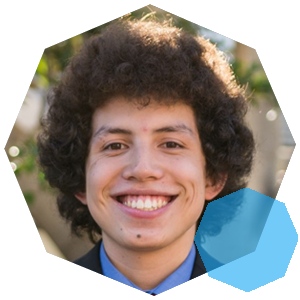
2021 Russell R. O’Neill Distinguished Service Award
Gabriel Luis Carlos Alpuerto
Alpuerto is graduating this spring with a bachelor’s degree in mechanical engineering. He volunteered as a mentor with the Engineering Transfer Bridge program and UCLA Tech Camp, and was a member and teaching assistant with the Center for Excellence in Engineering and Diversity’s (CEED) Summer Bridge program. He also was president of the American Society of Mechanical Engineers (ASME) at UCLA and served as the lead for the Fabrication and Design Essentials. In addition, Alpuerto was the public relations chair for the National Society of Black Engineers (NSBE) at UCLA, and a member of the Society of Latinx Engineers and Scientists (SOLES). He worked as a staff member at the UCLA Samueli Makerspace and a maintenance and reliability intern for Chevron. He was also part of the Bruin Underwater Robotics team. Alpuerto will begin graduate study at UCLA this fall, working towards a master’s degree in mechanical engineering with a concentration in design and manufacturing.
Q&A
During your time at UCLA, you’ve been a leader in STEM mentorship and educational spaces. What have you learned about mentorship and service through these experiences? Do you have any advice for students who want to engage in similar efforts?
I was once told: “Each generation is responsible for walking towards the future and as they stumble, they tell the generation behind them what to avoid and what works so that the new generation can go even further. Then in time, each generation can help the next go beyond and succeed like we never did.” As someone who has been mentored by others and eventually became a leader and mentor myself, I have learned and truly believe it is our responsibility to use the experiences and knowledge we gain to help others in any way we can. Whether it is educating or mentoring on technical or soft skills, you never know the impact you can have. In STEM, there can be a huge focus on the technical side, but we should not neglect the other side of professionalism, human interaction and altruism. It is important to find balance within STEM so students can have a holistic experience that not only makes them greater engineers but also prepares them to help others and themselves.
As for advice, there are two important things to remember. Communication and finding your passion. Communication is important, as you need to be able to convey information to others effectively while also listening to them and understanding how you can help. Passion refers to having some topic, skill, or knowledge that you are passionate about — enough to enjoy talking about. Whether you are teaching an entire group of students or mentoring a single person, anyone is capable of having a positive impact as long as you have the passion and know how to listen.
What was your motivation for advocating for and helping develop the UCLA Samueli Makerspace in Boelter Hall? How did it feel to be a part of the process?
As UCLA is a research-focused institution, it can be challenging for students in the engineering school to find hands-on experiences to supplement their academics. Before the Makerspace, the only opportunities for students were joining student organizations or working in research labs. However, while these instances are fantastic, they are sometimes limited resources-wise and have learning curves that limit accessibility to all students. That is where the Makerspace comes in to bridge the experience gap, while also providing new opportunities students normally would not have. As someone who has seen the benefit of having students take agency of their own learning, I was excited to hear that a makerspace was in development and wanted to do everything I could to help.
Being part of the process has been so fulfilling as a student. I was able to both find a place for myself while also helping others find their passions. Whether it is a busy evening helping a class of E96 students finish their final projects or helping a grad student learn different manufacturing techniques for their research, I have enjoyed being able to help others in whatever they need and shaping the space in collaboration with Professor Jacob Schmidt and the other staff members.
Looking back on your time at UCLA as you get ready to graduate, what lessons are you hoping to carry with you into the future?
As I graduate and move on to my master’s degree next year, I hope to continue to apply the lessons I gained in undergrad — namely time management, adaptability and perseverance — so I can continue to be learning from the different experiences life and school throw at me. My time at UCLA has helped me become more flexible in my approach to different situations and finding lessons in whatever happens, whether it ends in success or failure. This mentality of learning, rather than lamenting as different things happen, has helped me better focus on helping myself and giving me the opportunity to also help others.
While I have not figured out what path I will take after graduation, with time I hope to apply the academic knowledge, technical skills and lessons learned at UCLA in a fulfilling engineering career that focuses on design, manufacturing or robotics. In this role, I want to be able to help others also find their paths and hopefully help inspire the next generation to find what they are passionate about.
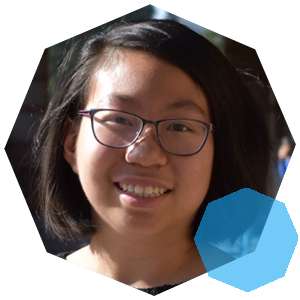
2021 Harry M. Showman Prize — Undergraduate
Angela Linghao Gao
Gao is getting a bachelor’s degree this spring in mechanical engineering, with a technical focus in computer science. She was a Fellow of UC LEADS (Leadership Excellence through Advanced Degrees) and a Rapid Fire Presentation finalist at the Society of Women Engineers’ WE20 National Conference. Gao conducted research in Professor Veronica Santos’ Biomechatronics Laboratory, served as a technical committee member for the Society of Women Engineers, and worked as a mentor for elementary, middle and high school students interested in STEM. She also earned the 2021 Outstanding Bachelor’s Student in Mechanical Engineering award from the Mechanical and Aerospace Engineering Department. After graduation, Gao will work as a staff research associate in the Department of Cell and Tissue Biology at UC San Francisco.
Q&A
What have you learned from being a researcher in Professor Veronica Santos’ lab for the past few years?
When I started research at Professor Santos’ lab, I was faced with the challenge of integrating the mechanical and electrical components of sensors that indirectly sense tendon tension of a 3 degree-of-freedom (DOF) robot manipulator. It was the first time the lab attempted to expand the manipulator from 2DOF to 3DOF and it took two other undergraduate students and me almost a year to overcome the challenge. The actual data collection only took two weeks. During that year, we experienced months when there was almost no progress on every front. Because it was one of my first experiences with research, I felt really discouraged. But after reading and hearing about stories of other people’s endeavors, I realized that there is often some sort of technical challenge that is associated with a research project. Whether it is getting G protein-coupled receptors to sit still during X-ray crystallography or seeing through dust to take pictures of the galaxy, these technical challenges are what’s holding us back from realizing the next breakthrough. Maybe there is even a positive correlation between the size of the technical challenge and the transformative power of a research project.
What did you do as a Technical Committee member for the Society of Women Engineers?
When I served on the Technical Committee for the Society of Women Engineers, I hosted workshops ranging from Introduction to 3D Printing to LED Papercraft for Valentine’s Day. While leading the papercraft workshop (and eating chocolate-covered strawberries), it was incredibly rewarding to watch a room full of female engineering students work on circuits, which is a very traditionally male-dominated field. It was even more satisfying to teach middle school girl scouts on similar concepts and see their faces lit up when their circuits worked for the first time in an annual volunteering event called “WOW! That’s Engineering Day.” More recently, the Technical Committee has been the organizational force behind QWER Hacks, UCLA’s first LGBTQIA+ hackathon. I feel very fortunate that UCLA Engineering takes diversity and inclusion very seriously.
You’ll be working as a staff research associate in the Department of Cell and Tissue Biology at UCSF after graduation. Why are you steering toward life sciences and how do you feel your time at UCLA Engineering will impact your next steps?
I get asked this question so many times, so thank you for asking and recording this. First of all, we should remind ourselves that abrupt departures from the physical to the biological sciences are not trailblazing anymore. In the 1950s, there were a whole bunch of physicists who were inspired by Erwin Schrödinger’s book titled “What Is Life?” to uncover the physical principles that govern life. I decided to pursue biology because I have been addicted to science since the time I took a freshman honors chemistry class. I am so glad I made this decision. I recently learned that some cells undergo phase transitions that can be described by the nucleation equations in my materials science textbook, suggesting that cells behave like metal! From a more practical standpoint, I am excited to use my engineering skills to design microfluidic devices to solve technical challenges associated with experiments. I think this highlights the importance of breadth in research. While of course depth is important, a breadth of knowledge allows you to think of unusual connections and ultimately new ideas that advance a field.
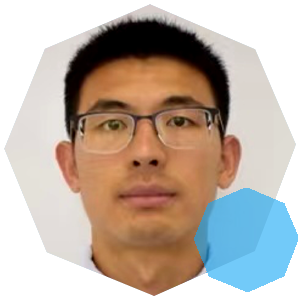
2021 Harry M. Showman Prize — Graduate
Weicheng Huang
Huang graduated in March with a Ph.D. in mechanical engineering. He joined UCLA after receiving his bachelor’s degree in engineering mechanics from Tongji University in Shanghai. His research interests are in the numerical simulation of mechanics, and in particular, how soft robots move and deform. Huang earned the 2021 Outstanding Ph.D. in Mechanical Engineering Award from the Mechanical and Aerospace Engineering Department, and received the UCLA Dissertation Year Fellowship. He worked as a teaching assistant for the advanced strength of materials course and was a graduate researcher in Professor M. Khalid Jawed’s research lab. During his time at UCLA, Huang published 15 papers and supervised three undergraduate researchers. In May, he joined Southeast University in Nanjing, China as an associate professor.
Q&A
Can you briefly explain your research in simple terms?
My research focused on developing numerical models for the dynamics in deformable structures. During my Ph.D. studies, we created several state-of-the-art numerical tools to systematically investigate the fundamental physics of slender bodies (e.g., gridshells and Möbius strips). Then, we built some novel algorithms to capture the complex locomotion in soft robots. For instance, we showed the robots rolling, jumping and swimming. With these well-established computational frameworks, optimized design and online control for nascent soft machines could be possible.
What sparked your interest in getting your Ph.D. in mechanical engineering?
When I first got in touch with the engineering mechanics at Tongji University, I was shocked to realize that the dynamics of all different objects could be exactly described by the same short but beautiful formulations. However, I felt that my understanding of the physical world was still limited even after obtaining a bachelor’s degree, because the mechanical models given at undergraduate level courses are usually simplified and not accurate, which failed to capture some complex phenomena found in our daily lives; for example, hair fluttering in the wind. To have a better understanding of the structural motions in the real world, I chose to pursue a Ph.D. in mechanical engineering.
You’ve submitted and published 15 papers in your time at UCLA. What has been the most rewarding part of researching and writing these pieces?
There were two rewarding things when I prepared for those publications. First, I felt quite excited when my simulations worked. There are always some bugs when building a novel numerical algorithm, and, as expected, it would usually involve a painstaking trial during the debugging process. However, because our numerical frameworks are aiming for the simulations of real physical objects (e.g., snow avalanches), I felt quite happy once my frameworks could predict the dynamic motions similar to the observations in our daily lives. Second, I felt rewarded when I introduced my research at an academic conferences. Our presentation shed light on some fundamental mechanics through multiple eye-catching picture animations, such that other researchers would pay more attention to our findings and interact with us. These experiences made me feel recognized within the community of mechanical engineering.
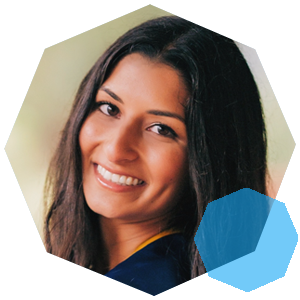
2021 Student Speaker
Maeneka Rai Grewal
Grewal graduated in the winter quarter of 2021 with a bachelor’s degree in computer science. During the past four years at UCLA, she served as a campus tour guide. She was involved in the DevX and Society of Women Engineers student organizations, and was a member of the Kappa Kappa Gamma sorority. Grewal will join Microsoft as a full-time program manager this fall.
Q&A
What was your favorite class at UCLA, and why?
There are two classes that really stand out to me during my time at UCLA. The first is CS 32, a rite of passage for all computer science students. Professor Carey Nachenberg’s hilarious slides and food-blasting cannons made learning fundamental data structures and algorithms an absolute hoot. Although the projects were challenging, this class reaffirmed my passion for computer science and made me feel even more confident that I could establish myself in this industry. The computer science field is sometimes daunting, but CS 32 and Professor Nachenberg had a way of making the pursuit of knowledge so exhilarating and worthwhile. Because he saw the potential in us, we saw the potential in ourselves.
My second favorite class was actually not an engineering class. It was MGMT 168: Personal Financial Health taught by Professor David Ravetch [at the Anderson School of Management.] I touched upon how his lessons so deeply impacted me in my commencement speech because what I learned in that class is perhaps one of the most important lessons I will take with me in life going forward. Professor Ravetch emphasized the idea that life is not just about achieving goals and making it to certain moments; life is about all the moments along the way.
Generally, what do you hope to convey to your fellow graduates in your message?
As mentioned above, the idea that life is made up of these constant beautiful moments, whether sad or happy, is what I want to convey to my fellow graduates. We are all such hardworking and ambitious students with big goals — that’s what makes us UCLA graduates! But if we live life only for the grand goal-achieving moments, we will miss everything in between. Looking back on my time at UCLA, there are so many moments that seemed so small and insignificant; yet they are the poignant moments that got me here and made me who I am — the internship rejections, the walks to class in the rain, the relief of passing a tough exam. Those moments are life. I hope my fellow graduates can reflect on their time at UCLA as well, and we can all appreciate life in a new way going forward as we work to achieve our goals.
Outside of classes, did you have another experience that you’re particularly proud of?
I was a campus tour guide for only two years, but it was the most rewarding job and experience I had while at UCLA. There are so many prospective students with such bright futures ahead of them who often do not know which college to choose, and they place their trust in campus tour guides. I was one of those prospective students once. I had no clue which college to choose, until I took a tour and envisioned the next four years at the campus that would become my home. Tour guides end every tour with “why we chose UCLA” and those moments where you can tell that another prospective student is ready to call UCLA their home were the best moments ever. I am so proud to know that in a couple of years, those students will be graduating just like me with immense gratitude and appreciation for the experience that is UCLA and how much it has helped us grow.
